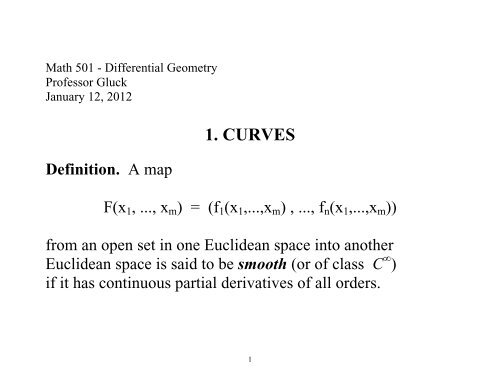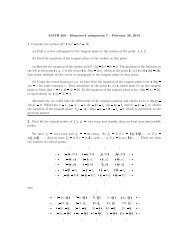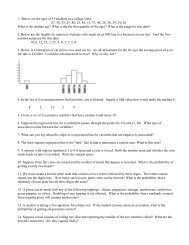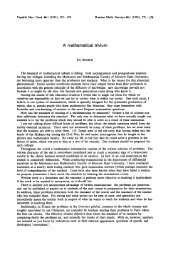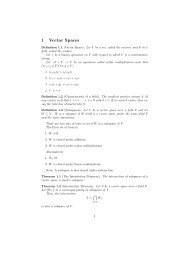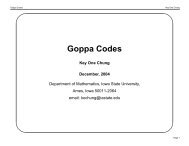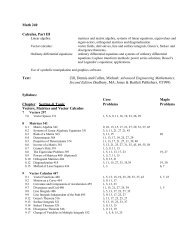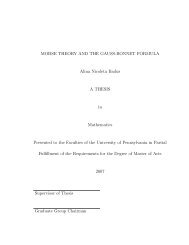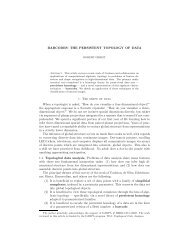regular smooth curve - Penn Math
regular smooth curve - Penn Math
regular smooth curve - Penn Math
You also want an ePaper? Increase the reach of your titles
YUMPU automatically turns print PDFs into web optimized ePapers that Google loves.
<strong>Math</strong> 501 - Differential Geometry<br />
Professor Gluck<br />
January 12, 2012<br />
Definition. A map<br />
1. CURVES<br />
F(x1, ..., xm) = (f1(x1,...,xm) , ..., fn(x1,...,xm))<br />
from an open set in one Euclidean space into another<br />
Euclidean space is said to be <strong>smooth</strong> (or of class C � )<br />
if it has continuous partial derivatives of all orders.<br />
1
In this chapter, we will be dealing with <strong>smooth</strong> <strong>curve</strong>s<br />
�: I � R 3 ,<br />
where I = (a, b) is an open interval in the real line R 3 ,<br />
allowing a = — � or b = + � .<br />
Do Carmo calls these "parametrized differentiable <strong>curve</strong>s",<br />
to emphasize that the specific function � is part of the<br />
definition. Thus<br />
�(t) = (cos t, sin t) and �(t) = (cos 2t, sin 2t)<br />
are considered to be different <strong>curve</strong>s in the plane, even<br />
though their images are the same circle.<br />
2
Examples.<br />
(1) The helix �(t) = (a cos t, a sint t, bt) , t � R<br />
(2) �(t) = (t 3 , t 2 ) .<br />
Problem 1. Let �(t) be a <strong>smooth</strong> <strong>curve</strong> which does not pass<br />
through the origin. If �(t0) is the point of its image<br />
which is closest to the origin (assuming such a point exists),<br />
and if �'(t0) � 0 , show that the position vector �(t0) is<br />
orthogonal to the velocity vector �'(t0) .<br />
3
Problem 2. Let �: I � R 3 be a <strong>smooth</strong> <strong>curve</strong><br />
and let V � R 3 be a fixed vector. Assume that<br />
�'(t) is orthogonal to V for all t � I and also that<br />
�(t0) is orthogonal to V for some t0 � I .<br />
Prove that �(t) is orthogonal to V for all t � I .<br />
Problem 3. Let �: I � R 3 be a <strong>smooth</strong> <strong>curve</strong>.<br />
Show that |�(t)| is constant if and only if<br />
�(t) is orthogonal to �'(t) for all t � I .<br />
4
Definition. A <strong>smooth</strong> <strong>curve</strong> �: I � R 3 is said to be<br />
<strong>regular</strong> if �'(t) � 0 for all t � I . Equivalently, we<br />
say that � is an immersion of I into R 3 .<br />
The <strong>curve</strong> �(t) = (t 3 , t 2 ) in the plane fails to be <strong>regular</strong><br />
when t = 0 .<br />
A <strong>regular</strong> <strong>smooth</strong> <strong>curve</strong> has a well-defined tangent line<br />
at each point, and the map � is one-to-one on a small<br />
neighborhood of each point t � I .<br />
Convention. For simplicity, we'll begin omitting the word<br />
"<strong>smooth</strong>". So for example, we'll just say "<strong>regular</strong> <strong>curve</strong>",<br />
but mean "<strong>regular</strong> <strong>smooth</strong> <strong>curve</strong>".<br />
5
Problem 4. If �: [a, b] � R 3 is just continuous, and<br />
we attempt to define the arc length of the image �[a, b]<br />
to be the LUB of the lengths of all inscribed polygonal<br />
paths, show that this LUB may be infinite.<br />
By contrast, show that if � is of class C 1 (meaning that<br />
it has a first derivative �'(t) which is continuous), then<br />
this LUB is finite and equals �a b |�'(t)| dt .<br />
6
Let �: I � R 3 be a <strong>regular</strong> (<strong>smooth</strong>) <strong>curve</strong>.<br />
Then the arc length along � , starting from some<br />
point �(t0) , is given by<br />
t<br />
s(t) = �to |�'(t)| dt .<br />
Note that s'(t) = |�'(t)| � 0 , so we can invert this<br />
function to obtain t = t(s) .<br />
Then �(s) = �(t(s)) is a reparametrization of our <strong>curve</strong>,<br />
and |�'(s)| = 1.<br />
We will say that � is parametrized by arc length.<br />
7
In what follows, we will generally parametrize<br />
our <strong>regular</strong> <strong>curve</strong>s by arc length.<br />
If �: I � R 3 is parametrized by arc length,<br />
then the unit vector T(s) = �'(s) is called the<br />
unit tangent vector to the <strong>curve</strong>.<br />
8
Problem 5. A circular disk of radius 1 in the xy-plane<br />
rolls without slipping along the x-axis. The figure<br />
described by a point of the circumference of the disk<br />
is called a cycloid.<br />
(a) Find a parametrized <strong>curve</strong> �: R � R 2 whose<br />
image is the cycloid.<br />
(b) Find the arc length of the cycloid corresponding to<br />
a complete rotation of the disk.<br />
9
Problem 6. Let �: [a, b] � R 3 be a parametrized <strong>curve</strong>,<br />
and set �(a) = p and �(b) = q .<br />
(1) Show that for any constant vector V with |V| = 1 ,<br />
b b<br />
(q — p) � V = �a �'(t) � V dt � �a |�'(t)| dt .<br />
(2) Set V = (q — p) / |q — p| and conclude that<br />
b<br />
|�(b) — �(a)| � �a |�'(t)| dt .<br />
This shows that the <strong>curve</strong> of shortest length from �(a)<br />
to �(b) is the straight line segment joining these points.<br />
10
Problem 7. Let �: I � R 3 be parametrized by arc length.<br />
Thus the tangent vector �'(s) has unit length. Show that<br />
the norm |�"(s)| of the second derivative measures the<br />
rate of change of the angle which neighboring tangents<br />
make with the tangent at s .<br />
Definition. If �: I � R 3 is parametrized by arc length,<br />
then the number �(s) = |�"(s)| is called the curvature<br />
of � at s .<br />
11
Problem 8. Show that the curvature of a circle is the<br />
reciprocal of its radius.<br />
Let �: I � R 3 be parametrized by arc length.<br />
When the curvature �(s) � 0 , the unit vector<br />
is well-defined.<br />
N(s) = �"(s) / |�"(s)|<br />
Problem 9. Show that the unit vector N(s) is normal<br />
to the <strong>curve</strong>, in the sense that N(s) � T(s) = 0 ,<br />
where T(s) is the unit tangent vector to the <strong>curve</strong>.<br />
Definition. When �(s) � 0 , we call N(s) the<br />
principal normal vector to the <strong>curve</strong>.<br />
12
Let �: I � R 3 be parametrized by arc length, and<br />
let T(s) be the unit tangent vector along � .<br />
If the curvature �(s) � 0 , then we also have the<br />
principal normal vector N(s) at �(s) .<br />
In that case, define the binormal vector B(s) to � at s<br />
by the vector cross product,<br />
B(s) = T(s) � N(s) .<br />
Problem 10. Show that B'(s) is parallel to N(s) .<br />
13
Definition. If �(s) � 0 , the torsion �(s) of the <strong>curve</strong><br />
� at s is defined by the formula<br />
B'(s) = — �(s) N(s) .<br />
This is the opposite sign convention from do Carmo.<br />
Problem 11. Find the curvature and torsion of the helix<br />
�(t) = (a cos t, a sin t, b t) .<br />
14
Problem 12. Let �: I � R 3 be parametrized by arc-<br />
length and have nowhere vanishing curvature �(s) � 0 .<br />
Show that<br />
T'(s) = �(s) N(s)<br />
N'(s) = — �(s) T(s) + �(s) B(s)<br />
B'(s) = — �(s) N(s) .<br />
15
Definition. The above equations are called the Frenet<br />
equations, and the orthonormal frame<br />
T(s) , N(s) , B(s)<br />
is called the Frenet frame along the <strong>curve</strong> � .<br />
16
THEOREM. Given <strong>smooth</strong> functions �(s) > 0<br />
and �(s) , for s � I , there exists a <strong>regular</strong> <strong>curve</strong><br />
�: I � R 3 parametrized by arc length,<br />
with curvature �(s) and torsion �(s) .<br />
Moreover, another other such <strong>curve</strong> �: I � R 3<br />
differs from � by a rigid motion of R 3 .<br />
This result is sometimes called the<br />
fundamental theorem of the local theory of <strong>curve</strong>s.<br />
17
Problem 13. The curvature of a <strong>smooth</strong> <strong>curve</strong> in the plane<br />
can be given a well-defined sign, just like the torsion of<br />
a <strong>curve</strong> in 3-space. Explain why this is so.<br />
Problem 14. Given a <strong>smooth</strong> function �(s) defined for<br />
s in the interval I , show that the arc-length parametrized<br />
plane <strong>curve</strong> having �(s) as curvature is given by<br />
where<br />
�(s) = (� cos �(s) ds + a , � sin �(s) ds + b) ,<br />
�(s) = � �(s) ds + �0 .<br />
Show that this solution is unique up to translation by (a, b)<br />
and rotation by �0 .<br />
18
Proof of the fundamental theorem<br />
of the local theory of <strong>curve</strong>s in R 3 .<br />
We are given <strong>smooth</strong> functions �(s) > 0 and �(s) , for s � I ,<br />
and must find a <strong>regular</strong> <strong>curve</strong> �: I � R 3 parametrized by arc<br />
length, with curvature �(s) and torsion �(s) .<br />
Let's begin by writing the Frenet equations for the Frenet frame.<br />
T'(s) = �(s) N(s)<br />
N'(s) = — �(s) T(s) + �(s) B(s)<br />
B'(s) = — �(s) N(s) .<br />
19
We'll view this as a system of three first order linear ODEs,<br />
with given coefficients �(s) and �(s) , for the unknown<br />
Frenet frame T(s) , N(s) , B(s) .<br />
We can also view it as a system of nine first order linear ODEs<br />
for the components of the Frenet frame.<br />
20
Now the fundamental existence and uniqueness theorem for<br />
systems of first order ODEs promises a unique "local solution",<br />
that is, a solution defined in some unspecified neighborhood of<br />
any given point s0 � I , with preassigned "initial conditions"<br />
T(s0) , N(s0) , B(s0) .<br />
Although for general systems we can only guarantee a local<br />
solution, for linear systems another theorem promises a unique<br />
"global solution", that is, one defined on the entire interval I .<br />
21
So we'll use that theorem, pick an arbitrary point s0 � I ,<br />
and pick an arbitrary "right handed" orthonormal frame<br />
T(s0) , N(s0) , B(s0) to get us started.<br />
Then we'll apply the global existence and uniqueness theorem<br />
for linear systems of ODEs to get a unique family of vectors<br />
T(s) , N(s) , B(s) which are defined for all s � I , which<br />
satisfy the Frenet equations, and which have arbitrary<br />
preassigned initial values T(s0) , N(s0) , B(s0) .<br />
22
Let's pause to check that the nature of the Frenet equations<br />
T'(s) = �(s) N(s)<br />
N'(s) = — �(s) T(s) + �(s) B(s)<br />
B'(s) = — �(s) N(s)<br />
guarantees that if we start off with an orthonormal frame<br />
T(s0) , N(s0) , B(s0) , then the solution will be an<br />
orthonormal frame for all s � I .<br />
23
Consider the six real-valued functions defined for s � I ,<br />
and obtained by taking the various inner products of the<br />
vectors T(s) , N(s) , B(s) :<br />
<br />
.<br />
When s = s0 , these six quantities start off with the values<br />
1 1 1<br />
0 0 0<br />
24
These six quantities satisfy a system of first order linear ODEs,<br />
obtained from the Frenet equations. For example,<br />
' = 2 <br />
= + <br />
= �(s) — �(s) + �(s) ,<br />
and so forth.<br />
25
The constant solution<br />
=1 = 1 = 1<br />
= 0 = 0 = 0<br />
satisfies this system of ODEs, with the given initial<br />
conditions, so by uniqueness this is the only solution.<br />
Conclusion: If the vectors T(s) , N(s) , B(s) start out<br />
orthonormal at s0 � I , then they remain orthonormal<br />
for all s � I .<br />
26
Where are we so far?<br />
We have proved that, given <strong>smooth</strong> functions �(s) > 0<br />
and �(s) defined for all s � I , and an orthonormal<br />
frame T(s0) , N(s0) , B(s0) defined for some s0 � I ,<br />
then there is a unique orthonormal frame T(s) , N(s) , B(s)<br />
defined for all s � I with these preassigned initial values,<br />
and satisfying the Frenet equations throughout I .<br />
27
Now, to get the <strong>curve</strong> �: I � R 3 defined for s � I<br />
and having the preassigned curvature �(s) > 0 and<br />
torsion �(s) , just pick the point �(s0) at random<br />
in R 3 and then define<br />
s<br />
�(s) = �(s0) + �so T(s) ds .<br />
We get �'(s) = T(s) , which is a unit vector,<br />
so � is parametrized by arc-length.<br />
28
The Frenet equations<br />
T'(s) = �(s) N(s)<br />
N'(s) = — �(s) T(s) + �(s) B(s)<br />
B'(s) = — �(s) N(s)<br />
then tell us that the <strong>curve</strong> � has curvature �(s) and<br />
torsion �(s) , as desired.<br />
29
Once the point �(s0) and the initial orthonormal frame<br />
T(s0) , N(s0) , B(s0) is picked, the <strong>curve</strong> is unique.<br />
Thus any other such <strong>curve</strong> �: I � R 3 differs from �<br />
by a rigid motion of R 3 .<br />
This completes the proof of the fundamental theorem of<br />
the local theory of <strong>curve</strong>s in R 3 .<br />
30
Problem 15. Let �: I � R 3 be a <strong>regular</strong> <strong>curve</strong> with<br />
nowhere vanishing curvature. Assume that all the<br />
principal normal lines of � pass through a fixed point<br />
in R 3 . Prove that the image of � lies on a circle.<br />
Problem 16. Let r = r(�) , a � � � b , describe a plane<br />
<strong>curve</strong> in polar coordinates.<br />
(a) Show that the arc length of this <strong>curve</strong> is given by<br />
�a b [r 2 + (r') 2 ] 1/2 d� .<br />
(b) Show that the curvature is given by<br />
�(�) = [2(r') 2 — r r" + r 2 ] / [(r') 2 + r 2 ] 3/2 .<br />
31
Problem 17. Let �: I � R 3 be a <strong>regular</strong> <strong>curve</strong>, not<br />
necessarily parametrized by arc length.<br />
(a) Show that the curvature of � is given by<br />
�(t) = |�' � �"| / |�'| 3 .<br />
(b) If the curvature is nonzero, so that the torsion is<br />
well-defined, show that the torsion is given by<br />
�(t) = (�' � �") � �''' / |�' � �"| 2 .<br />
32
Definitions. A closed plane <strong>curve</strong> is a <strong>regular</strong> <strong>curve</strong><br />
�: [a, b] � R 2 such that � and all its derivatives<br />
agree at a and at b , that is,<br />
�(a) = �(b) , �'(a) = �'(b) , �"(a) = �"(b) , ... .<br />
Alternatively, one can use the entire real line as domain,<br />
�: R � R 2 , and require that � be periodic of some<br />
period L > 0 , that is, �(t + L) = �(t) for all t � R .<br />
Another alternative: one can use a circle (of any radius)<br />
as the domain for a closed <strong>curve</strong>.<br />
33
A <strong>curve</strong> is simple if it has no further intersections, other<br />
than the coincidence of the beginning and end points.<br />
If we use a circle for the domain, �: S 1 � R 2 , then<br />
the <strong>curve</strong> is simple if � is one-to-one. Since S 1 is<br />
compact, this is the same thing as saying that � is<br />
a homeomorphism onto its image.<br />
34
If �: [a, b] � R 2 is a <strong>regular</strong> closed <strong>curve</strong> in the plane,<br />
parametrized by arc length, then its total curvature is<br />
defined by the integral<br />
b<br />
Total curvature = �a �(s) ds .<br />
35
Problem 18. (a) Show that the total curvature of a <strong>regular</strong><br />
closed <strong>curve</strong> in the plane is 2n� for some integer n .<br />
(b) Show that if the <strong>regular</strong> closed <strong>curve</strong> is simple,<br />
then n = +1 or —1 .<br />
(c) Suppose that a <strong>regular</strong> closed <strong>curve</strong> in the plane has<br />
curvature which is strictly positive or strictly negative,<br />
and that the above integer n equals +1 or —1 .<br />
Show that the <strong>curve</strong> is simple.<br />
36
Let �: S 1 � R 2 be a <strong>regular</strong> closed <strong>curve</strong> in the plane.<br />
For each point � � S 1 , the unit tangent vector T(�) to<br />
the <strong>curve</strong> at the point �(�) is given by<br />
T(�) = �'(�) / |�'(�)| .<br />
Thus T: S 1 � S 1 , and then the induced map<br />
T* : �1(S 1 ) � �1(S 1 )<br />
is a group homorphism from the integers to the integers,<br />
and hence is multiplication by some integer n , which we<br />
call the degree of the map T , or the winding number or<br />
rotation index of the <strong>curve</strong> � .<br />
37
Problem 19. Show that this integer n is the same as the<br />
integer n in the previous problem, that is, show that the<br />
total curvature of the <strong>curve</strong> � is 2�n .<br />
Definition. Let �0 and �1 : S 1 � R 2 be <strong>regular</strong> closed<br />
<strong>curve</strong>s in the plane. A homotopy<br />
A: S 1 � [0, 1] � R 2<br />
between �0 and �1 is said to be a <strong>regular</strong> homotopy<br />
if each intermediate <strong>curve</strong>, �t : S 1 � R 2 , defined by<br />
�t(�) = �(� , t) , is a <strong>regular</strong> <strong>curve</strong>.<br />
38
Remark. If �0 and �1 : S 1 � R 2 are <strong>regular</strong>ly<br />
homotopic, then they have the same winding number.<br />
WHITNEY-GRAUSTEIN THEOREM. Two <strong>regular</strong><br />
<strong>curve</strong>s �0 and �1: S 1 � R 2 are <strong>regular</strong>ly homotopic<br />
if and only if they have the same winding number.<br />
39
Volumes of tubes...two problems.<br />
(1) Show that the area of a tube of radius � about a<br />
simple closed <strong>curve</strong> of length L in the plane is 2� L .<br />
(2) Show that the volume of a tube of radius � about<br />
a simple closed <strong>curve</strong> of length L in 3-space is � � 2 L .<br />
We will solve both of these problems, and the<br />
Frenet equations for <strong>curve</strong>s will be our main tool.<br />
40
Tubes about circles in the plane.<br />
The simplest example is that of a tube of radius � about a<br />
circle of radius r in the plane, so just an annulus between<br />
concentric circles of radii r + � and r � � , with area<br />
� (r + �) 2 � � (r � �) 2 = � 4r� = (2�r) (2�)<br />
= (circumference of circle) (width of tube)<br />
41
Tubes about any <strong>curve</strong> in the plane.<br />
Parametrize the <strong>curve</strong> by arc length: x = x(s) for 0 � s � L .<br />
Let T(s) = x'(s) and N(s) denote unit tangent and normal<br />
vectors along the <strong>curve</strong>.<br />
Frenet eqns: T'(s) = �(s) N(s) and N'(s) = � �(s) T(s) .<br />
42
To produce the �-tube about this <strong>curve</strong>, we define<br />
by<br />
F: {0 � s � L} � {�� < t < �} � R 2<br />
F(s, t) = x(s) + t N(s) .<br />
Then the partial derivatives of F are given by<br />
Fs = x'(s) + t N'(s) = T(s) + t (��(s) T(s))<br />
Ft = N(s) .<br />
= (1 � t �(s)) T(s)<br />
43
Hence the area of the �-tube about our <strong>curve</strong> is given by<br />
�s �t |det dF| dt ds = �s �t (1 � t �(s)) dt ds<br />
= �s (t � 1/2 t 2 �<br />
�(s))|–� ds = �s 2� ds = L . 2�<br />
= (length of <strong>curve</strong>) (width of strip),<br />
independent of the nature of the <strong>curve</strong>.<br />
44
Tubes about any <strong>curve</strong> in 3-space.<br />
Parametrize the <strong>curve</strong> by arc length: x = x(s) for 0 � s � L .<br />
Frenet frame along the <strong>curve</strong>: T(s) = x'(s) , N(s) , B(s) .<br />
Frenet eqns: T'(s) = �(s) N(s)<br />
N'(s) = � �(s) T(s) + �(s) B(s)<br />
B'(s) = � �(s) N(s)<br />
45
To produce the �-tube about this <strong>curve</strong>, we define<br />
by<br />
F: {0 � s � L} � {t 2 + u 2 < �} � R 3<br />
F(s, t, u) = x(s) + t N(s) + u B(s) .<br />
Then the partial derivatives of F are given by<br />
Fs = (1 � t �(s) T(s) � u �(s) N(s) + t �(s) B(s)<br />
Ft = N(s)<br />
Fu = B(s)<br />
46
Hence the volume of the �-tube about our <strong>curve</strong> is given by<br />
�s �t2+u2
Problem. To get a Frenet frame along a <strong>curve</strong> in R 3 , one<br />
needs to assume that the curvature �(s) never vanishes.<br />
Without this hypothesis, one can still prove that<br />
vol �-tube = (length of <strong>curve</strong>) (area of �-disk) .<br />
(a) Let T(s) , A(s) , B(s) be an ON frame along our<br />
<strong>curve</strong> x(s) . Show that the Frenet eqns are replaced by<br />
T'(s) = �(s) A(s) + �(s) B(s)<br />
A'(s) = � �(s) T(s) + �(s) B(s)<br />
B'(s) = � �(s) T(s) � �(s) A(s) .<br />
48
(b) Defining the �-tube about our <strong>curve</strong> x(s) by<br />
F(s, t, u) = x(s) + t A(s) + u B(s) ,<br />
with T(s) = x'(s) , and hence A(s) and B(s) orthogonal to<br />
the <strong>curve</strong>, show that we get<br />
vol �-tube = �s �t 2+u 2
Tough Problem. Show that for a <strong>smooth</strong> <strong>curve</strong> in R n ,<br />
we get<br />
vol �-tube = (length of <strong>curve</strong>) (vol B n–1 (�)) ,<br />
where B n–1 (�) is a round ball of radius � in R n–1 .<br />
50
Tubes about round spheres in 3-space.<br />
51
The "tube" of radius � about a round sphere of radius r in<br />
3-space is just the region between the concentric spheres of<br />
radii r + � and r � � , with volume<br />
4/3 � (r + �) 3 � 4/3 � (r � �) 3 = 4/3 � (6 r 2 � + 2 � 3 )<br />
= (4 � r 2 ) 2� + 8/3 � � 3 = (area of sphere) 2� + 8/3 � � 3<br />
= 2� (area of sphere + 2�/3 �(sphere) � 2 ) ,<br />
which is exactly "Weyl's tube formula" for surfaces in R 3 .<br />
52
Problem. Compute the volume of the �-tube about<br />
a torus of revolution in 3-space, and show that it is<br />
vol �-tube = 2� (area of torus)<br />
= 2� (area of torus + 2�/3 �(torus) � 2 ) ,<br />
since �(torus) = 0 , again in accord with Weyl's<br />
tube formula.<br />
53


